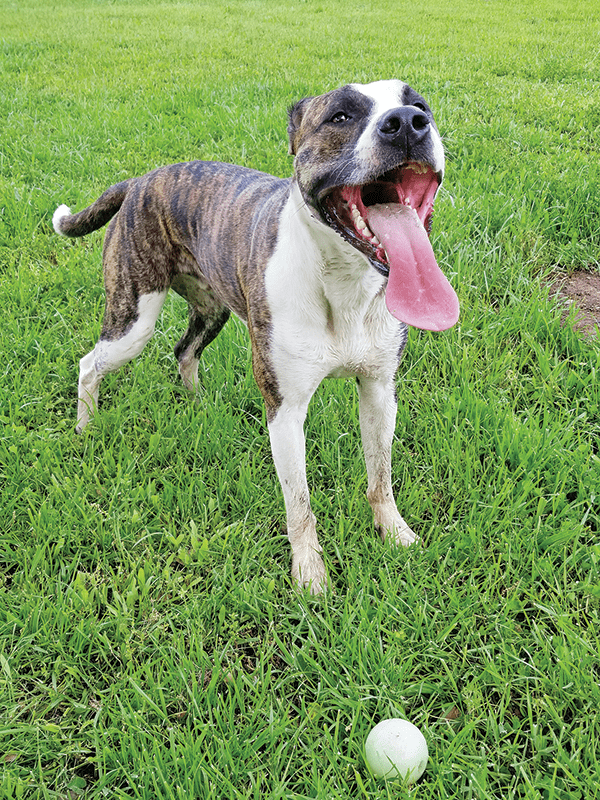Summer is a great time to be a dog owner. Long warm days mean plenty of outdoor activities like swimming, hiking, and playing. It’s important to remember however, that just like us, our canine friends can overheat. As a result, taking precautions in the spring and summer is critical. With attention to your dog’s behavior in the heat and preparation for the season, you can avoid a heat stroke.
What Causes Heat Stroke?
The canine body operates best in a very narrow temperature range – usually from 99 to 102 degrees. Above 109, and body systems will become severely damaged.
The dog’s temperature is tightly controlled by the hypothalamus, an area in the brain. Elevations in temperature can be caused either by endogenous factors (inside the body) or exogenous (outside).
Fever occurs when the hypothalamus resets the normal body temperature higher as a result of infection or inflammation. It is initially a beneficial response, as it enhances the ability of the immune system to destroy viruses and bacteria. With fever, trying to cool a dog down will not help, as the brain is controlling the body temperature. It will only lead to shivering as the body tries to rewarm to the new set point. This is uncomfortable and expends energy. Cooling is not recommended for fevers.
Heat stroke (hyperthermia) is caused by external factors such as a hot environment or overexertion in the heat. The brain set temperature is normal, but a dog is unable to cool effectively, and so body temperature rises.
Dogs cool by two mechanisms: evaporation and conduction. Evaporation of heat occurs with heavy panting. Conduction occurs when a hot dog lies on a cool surface and heat is transferred. Dogs sweat very minimally and only through their footpads, so this is not a significant means of cooling.
Heat stroke progresses through three stages. It begins with heat stress. Initially, a dog will pant heavily, seek a cool surface, and drink water to bring body temperature down.
If a dog cannot do these things or cannot do them effectively (such as when trapped in a hot car), heat stress develops into heat exhaustion. The panting becomes much faster, heart rate elevates, the gums become red and tacky, and body temperature is likely greater than 106 degrees.
If this goes unaddressed, heat stroke develops. Body temperature exceeds 109 degrees. A dog will vomit, have profuse diarrhea, begin to seizure, and collapse.
Most Susceptible Dogs
All dogs can have heat strokes, but some are more prone to developing problems. Brachycephalic breeds like Bulldogs, Boston Terriers, and Boxers are notorious for overheating. Due to breed-related airway abnormalities such as small nostrils, long floppy palates and tonsils, and narrow, weak windpipes, brachycephalic dogs can overheat very quickly.
However, Labradors and other breeds vulnerable to laryngeal paralysis, another obstructive upper airway disease, are also at significantly increased risk. Dogs with cardiac disease can be predisposed, as well.
Another consideration is whether a dog is conditioned enough to be in the heat. Dogs who are not accustomed to exercise and exert themselves in hot weather can suffer heat stroke very rapidly. This is especially true if they are overweight or elderly.
Most commonly, any dog left in an unventilated car in temperatures above 65 degrees can suffer from heat stroke. This is most often seen in the spring and summer.
Symptoms
Heat stroke is not immediate. Symptoms begin with heavy panting and restlessness. This progresses to weakness and collapse, followed by profuse vomiting and diarrhea (often bloody). As heat stroke continues, a dog will become extremely dull to non-responsive. Seizures can develop in the late stages. Red to purple spots and patches may become visible on the skin.
Once the heat stroke goes untreated, every body system becomes involved. Shock develops. This means decreased oxygen delivery to tissue, which eventually leads to multiple organ dysfunction syndrome (MODS).
In the kidneys, the renal tubules (responsible for conserving water and electrolytes) are damaged. Water, glucose, and electrolytes are lost instead of conserved. Potassium, instead of being excreted, is retained. High levels of potassium causes cardiac arrhythmias.
The ability to clot blood is also severely affected. Coagulation proteins are made in the liver, and they function within the body’s normal temperature range. At above 109 degrees, they are damaged, and clotting becomes difficult. This leads to visible bruising on the skin called petechiae. When these coalesce into large patches, they are called ecchymoses. It is especially visible on the belly, where there is less hair, on the gums, the white of the eye (sclera), and inside the ear pinna.
Liver damage also occurs due to shock. The liver is essential for many functions. Two of the most important are production and storage of glucose, the body’s energy source, and the manufacture of clotting factors. Most dogs suffering heat stroke will have low blood glucose levels due to liver damage. Brain tissue is likewise affected leading to swelling of neurons. This can cause stupor, seizures, coma, and death.
The cells lining the gastrointestinal tract start to die as a result of the hyperthermia. Once those cells are damaged, the protective lining of the intestines weakens and thins, leading to bacteria moving freely into the bloodstream (bacterial translocation). This causes “blood poisoning” or sepsis.
Every system of the body feels the effects of heat stroke, making prompt care imperative to recovery.
Treatment
Treatment of true heat stroke must be rapid and aggressive. Immediately cool your dog if you suspect heat exhaustion. If you have a hose or bathtub, wet your dog down with cold water thoroughly, especially the paw pads and thinly haired areas like the stomach (this will help dissipate heat quicker). If you are outdoors and near a body of water, a quick dip can help bring down temperature.
After cooling, take your dog to the veterinarian. Do not wait to see if he improves, as heat stroke can be deadly in a matter of hours.
Heat stroke causes shock, and this must be treated quickly. Initial vitals will be taken while the veterinary team works to stabilize your dog. If you have already cooled your dog at home, the temperature may be lower than expected, but this does not mean your dog has not had a heat stroke.
An intravenous (IV) catheter will be placed, and cool fluids will be given rapidly. This will increase blood flow to all parts of the body and improve oxygen delivery. Fans and cold water will be applied to bring body temperature down. Oxygen should be supplied either via face mask or nasal prongs. Ice chips in the oxygen mask can cool and moisten the air to further increase cooling.
Additional treatments should include broad spectrum antibiotics to protect against bacterial translocation and sepsis, IV dextrose to maintain normal blood sugar levels, mannitol or hypertonic saline to decrease cerebral edema (swelling in the brain), and continued oxygen and IV fluids. Fresh frozen plasma may be given in cases where clotting abnormalities have already developed. The plasma can provide clotting factors when the liver cannot manufacture its own or when they are deactivated by hyperthermia.
Prognosis
The prognosis is always guarded, as uncontrolled hyperthermia leads to multiple organ damage. Immediate, intensive care will improve the prognosis. Hospitalization can be prolonged, often at least 48 to 72 hours. During that time, frequent vitals and bloodwork should be conducted, including tests of clotting times and blood glucose.
Avoiding Heat Stroke
When the weather warms up, it is important to slowly acclimate your canine companion to the weather. Heat and humidity both play a role in overheating, and even on moderately warm days, if the humidity is high, overheating can occur. Plan exercise and activities for the cooler parts of the day – around sunset and early in the morning. If the temperature is moderately hot, your dog can spend short periods of time outdoors to acclimate. Do not exercise an unconditioned dog in the heat.
Any dog with upper airway abnormalities or cardiac disease should have minimal outdoor time in the summer. At the first sign of any overheating, they should be calmed and aggressively cooled with a hose or bath. This includes brachycephalic breeds and dogs with laryngeal paralysis and heart disease.
Make sure when your dog is outside that he has shade and plentiful fresh water. Keeping it cold and fresh may encourage your dog to drink more. Replenish frequently and add ice cubes. A kiddie pool filled with cold water is also excellent for the water-loving canines. If you plan to visit a dog park, choose one that has water nearby for swimming and playing.
There are an array of cooling devices that can be found for purchase including vests, sleeping pads, dog houses, and collars. (The best of these were recommended in “How to Prevent Heat Stroke in Dogs,” in the July 2015 issue.)
The best tip to remember is, if you’re in doubt, err on the side of caution and avoid overdoing it!







Very informative and timely article, thank you. I adopted a 12 year old black lab mix last September who loves to go on walks and we walk 3x a day. Now that the weather is getting warmer, she is not as interested in walking. It’s not that hot here yet, but I wonder if her shiny black coat absorbs more heat than a lighter color would? This is our first summer together so I’ll be walking her when it’s cooler and watching for any signs of heat stroke.
Yes, that’s definitely the case. Darker coats just soak up the sun. And her age makes her vulnerable as well.
I wonder if you know of anyone doing research on Border Collie Collapse? I believe one of my girls suffers from this and heat definitely makes it worse. I bought one of the cooling vests recommended by WDH, and that seems to help. But I’d really like more information than what I’ve so far found online.
I have a 1 yr old chocolate Australian Kelpie / Lab mix (we suspect). Her tongue comes *all* the way out of her mouth & she looks to be panting heavily even though she’s thin & young & gets a reasonable amount of exercise. She also “dances” on the concrete because her feet hurt from the heat on an 85°
day when she goes out for a midday potty break. I’ve told the dog walker to try to keep her on the grass & take the shady route when they walk but I’m worried she may be more sensitive to the heat than most dogs. But she waits all day for her walk. So I’d hate for her to not go. At the same time I don’t want her overheating or burning her feet! What to do?!? We are in DC do I didn’t think it was that hot compared to the Phoenix hit I grew up in.
85 is way too hot for walking on pavement. Booties or changing walk times
85 is way too hot for walking on pavement. Booties or changing walk times also research some cooling coats. Some u immerse in cold water and crystals keep the coat cool.
Alex, best get some doggy booties for your pup, if you are going to continue walks on hot pavement!
I also have a dark brown labradoodle female during the summer months I only take her running/walking before sunrise or late sunset and she does well. Once the sun begins to raise regardless, of current cool temperature she will begin to pant more. As both of us begin to age, I too, have better runs early in AM. Use common sense, if you cant take running ob concrete or asphalt BAREFOOTED because of the heat..what Makes think your dog could tolerate it !!!
I wish your article had mentioned bringing dogs from sea-level towns to the mountains and hiking with them. The dog’s body is not adapted to the higher altitude, and the rigorous exercise on a warm day can be lethal. I know someone who lost a golden retriever this way.
Everyone comments on how smart my lab-mix rescue is, but he must be stupid or enjoy pain. Even at this time of year, with a hot sun & 90°-plus temperatures, he’ll choose to walk on the sidewalk nearly as often as he’ll choose to use the grass. His walks are off leash, so he always has a free choice. Yes, I completely agree with paying close attention to your dog for discomfort or stress, but common sense doesn’t necessarily dictate booties or keeping your dog inside when he wants to get out. It depends on the dog, the heat & humidity, shade or sun, duration outside, etc. As far as leaving a dog in the car (a subject addressed in the print version of this article), a few suggestions that might work if your dog is well behaved & travels with you as often as mine does. Get a vehicle with a hatchback & leave it open (along with the windows) whenever your dog must be left in the car. The leash should be long enough to allow him to move around but short enough to keep him fully secured inside the vehicle. Always have water, of course, & park in the shade or park so that the back of your car is shaded from the sun. My dog has accompanied me nearly everywhere for 9 years, paws hanging out of the open back of the vehicle watching the world go by when I can’t take him into a shop. Over the years, many people have stopped to say hello to him, with or without my permission. Only once did someone call the police. My wife & I saw the officer arrive from the restaurant window, so I went outside. My dog greeted the officer, they shook hands, & he looked my dog over. “Your dog sure looks fine to me,” he concluded before offering a treat & returning to his squad car.
Good information, especially this summer. High temperature so far this summer was 40.6 C but it hovers around 36C most days.
I feel so fortunate to be born and have always lived in the Pacific NW. I live near a flowing creek in my city,, but 2-3 times a week I take my 15 and 12.5 yr old dogs to the country, where I grew up, to swim in the river and various creeks. We might see one person, if that. Paradise.
Some states make illegal to leave a dog or a child in the car no matter the temperature or time of year!! A car can heat to 140 degrees in a few minutes even with the windows open. In Arizona any bystander can break into a car to rescue endangered children or pets without incurring charges if the call they police first. You can’t wait for cops to arrive sometimes. Every year in Arizona children and pets die in cars!!!
I agree. It doesn’t matter how many windows you leave open, you can always count on the temperature in a car being at least 20 degrees hotter than the actual reported temperature, and probably even hotter if you have a dark colored car. It always bothers me when I see a dog panting in a car with all the windows open, and I wait until the owner returns before I leave. When I have to leave my dog in the car as I’m running errands, I leave the car running with the emergency brake on and the AC running full blast. Even then I only feel comfortable leaving her for a few minutes at a time.
My dog is black, and she definitely feels the heat more. Her coat just soaks up the sun. Plus, she gets so excited for her walks that she’s panting before we even step outside. She definitely will wear herself out, so I have to be the one who decides when we head for home. She’s definitely not happy about the shortened walks, but when I see her head for the coolest room in the house and drop to the floor when we get home, I know I’ve done the right thing. I tried the cooling vest, but it just seems to make her hotter. When it’s in the high 80’s / 90’s, I won’t take her period. I just hide treats in the house and she gets a good 15-20 minute exercise session that way. Keep in mind that the “dew point,” not only the humidity, also has a lot to do with what it feels like outside.